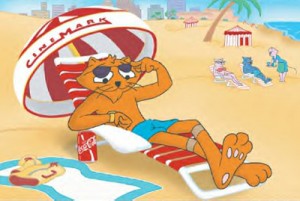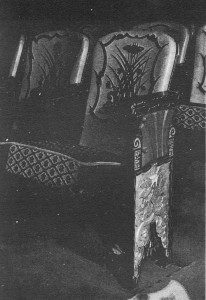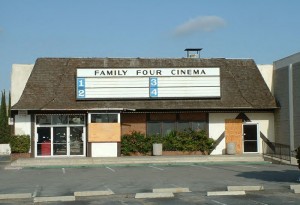Corporate mascots have long been utilized as a marketing tool, to aid in creating a brand identity and accessible “face” for, otherwise, sterile business entities. While theatre operators have never managed to establish a mascot persona as recognizable as Ronald McDonald or the Geico Gecko, many have certainly attempted to place a colorful character at the helm of their corporate images; and, the 1990’s may have marked the theatre industry’s greatest push to initiate the use of mascots.
.

.
Prior to the early 90’s, theatre chains often placed, seemingly anonymous, characters in print advertising, policy trailers, and official literature. From humanized food items, to buffoonish cartoon patrons/staff, to non industry specific figures (ex: Pacific Drive-In’s weird grinning clown), the value of mascot imagery was recognized from the onset, but seldom executed in a purposeful fashion. Character identities were either undefined or not widely promoted; figures varied greatly between media runs, never establishing a long term presence; or, in the case of those operators who licensed and/or “borrowed” well known imagery, lines of brand identity were blurred. However, this all began to change towards the end of the multiplex era.

The first defined and recognizable theatre mascot is surely up for debate (perhaps, the adult Pussycat Theatres’ “Pussycat Girl” of the 70’s?), but the “golden era” or cinema mascots was kicked off in the late 80’s, when Cinemark established “Front Row Joe”. A cartoon feline, who bares an unmistakable likeness and personality to Frito-Lay’s Chester Cheetah, Joe began appearing in the chain’s pre show policy trailers around 1988. Usually featured in musical or comedy theme pieces, he was joined by an expanding cast of characters, which included a female interest, in “Popcorn Penny”, and villains “Elton” and “Clyde” (who were generally utilized to vilify poor movie going etiquette). When not greeting movie goers or wishing them a happy holiday season, Joe tended to focus on movie going life lessons.

Following close on the heels of Front Row Joe came General Cinema’s “Popcorn Bob” and AMC’s “Clip”. Bob, who’s presence was originally produced by George Lucas’ Lucasfilm, in 1993, was a broom handle nosed bag of popcorn; often joined in musical numbers by his “Candy Band” (which included “Pepsi Sue”). Clip, a creation of the Los Angeles based Metrolight Company, in 1994, an animated collection of film strips, which formed a stick figure like character, that surfed about and made squeaking noises. As with Cinemark’s Front Row Joe, Bob and Clip became mainstays of their respective chains’ policy trailers and literature. However, unlike Joe, they were also featured as facility decor. This was especially true of AMC’s Clip, who’s waving image was emblazoned across nearly any surface in need of decoration. Naturally, all three were personified via large foam rubber costumes, which were lent out for theatre openings and PR events (unfortunately, Clip’s costume replication resulted in a somewhat frightening and unnerving appearance).
Numerous other chains produced their own mascots during this period, with varying degrees of success, but the “big three”, of Joe, Bob, and Clip, remained the closest thing the industry ever had to the Michelin Tire Man. Each underwent significant upgrades in the new millennium, with Joe and Bob looking far more CGI as time passed. Clip proved to be the most constant of the bunch; while never achieving wide spread name recognition, “that film thing” has continued to be a cornerstone feature at AMC to the present day. Front Row Joe, while drifting out of use for a few years, reemerged recently; all be it in a less prevalent fashion. Sadly, Popcorn Bob completely disappeared from the scene after General Cinema Corporation was absorbed by AMC in 2002.

Today, aside from Clip, theatre operators appear to have abandoned their efforts to create memorable or identity defining corporate mascots. The highly customized policy trailers have been replaced by commercials and generic logos streaking across the screen. Friendly characters have given way to product placement and “alluring” concession combo deals. While lasting little more than a decade, the golden era of cinema mascots has passed.
UPDATE 1/6/2020: Not long after this article was first published AMC discontinued Clip, as part of a brand refresh. The film based Clip had become a dated figure in the company’s move to digital projection.
Tags:













